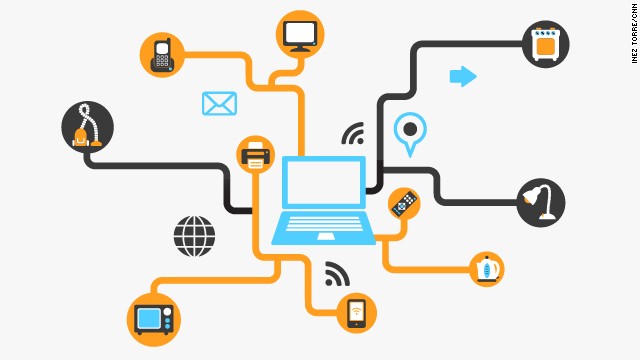-
Arren Soroko changed their profile picture 6 years, 2 months ago
-
Jacklin Altman's profile was updated 6 years, 9 months ago
-
Jacklin Altman's profile was updated 6 years, 9 months ago
-
Jacklin Altman changed their profile picture 7 years, 2 months ago
-
Brittany M Cougle wrote a new post on the site MIS4596 – Section 3 Spring 2015 9 years, 6 months ago
In the U.S more than $2.5 trillion flows through car-related industries every year. This article states that where this money will flow in the future depends on whether cars will require human drivers. The big […]
-
Brittany M Cougle wrote a new post on the site MIS4596 – Section 3 Spring 2015 9 years, 6 months ago

Target partnered with Lilly Pulitzer, a luxury clothing line, and created a collection that would sell at a fraction of the cost of regular Lilly Pulitzer items. The demand for the product line was incredible […] -
Arren Soroko wrote a new post on the site MIS4596 – Section 3 Spring 2015 9 years, 6 months ago
In this UX Magazine article, author Avi Itzkovitch disucusses how the Internet of Things can be used to create disruptive innovations. The main point of this article talks about how connecting a device or […]
-
Dominic P Lyate wrote a new post on the site MIS4596 – Section 3 Spring 2015 9 years, 6 months ago
In this article by Kara Swisher of Re/code, Color, a new at-home breast and ovarian cancer-risk screening company, is at the center of attention. The company produces $249 physician-ordered kits that screen […]
-
I think this is a great idea because so many women choose not to get screened for breast and ovarian cancer because they do not want to visit a doctor’s office. These kits would make it much easier for women to get tested and will hopefully decrease the number of deaths from breast and ovarian cancer. I do think there are some risks involved with sending genetic information through the mail or posting online and this will turn some people away from the kits. However, for me, the benefits outweigh the risks and I would be interested to see if similar kits could be designed to test for other types of cancer or disease.
-
-
Arren Soroko wrote a new post on the site MIS4596 – Section 3 Spring 2015 9 years, 6 months ago
In this article entitled Integrative Thinking, author Graham Douglas explores the differences between critical thinking and integrative thinking and addresses how we are programmed to think critically because […]
-
I think some of the points Douglas makes are interesting, especially the parts about making a “narrative” for connecting wonderings, ideas, etc. I think the narrative helps give some context to general terms like “integrative thinking.” However, I have an issue with the first point above. Douglas argues that we’ve been conditioned by our education to break things into parts–but then suggests that we “memorize” categories that help trigger connections. I think that methodology sounds really similar to what our education teaches us–breaking things down, analyzing them, making connections, etc. I think staying away from breaking things down helps build a more holistic view of each problem.
-
I too posted an article on integrative thinking and do agree with what Douglas. I do think that our education conditioned us to find a problem, break it down, analyze, and find one solution for the problem.I thiink it’s okay to continue to break problems down, but we shouldn’t focus only one part of the problem. We should focus on the entire problem. I also believe that every person has the potential to become an integrative thinker. There are those rare people, who are integrative thinkers already, but I also think one can practice to become an integrative thinker. The more one practices and puts himself/herself in these situations, the easier it will be to become an integrative thinker.
-
-
Dominic P Lyate wrote a new post on the site MIS4596 – Section 3 Spring 2015 9 years, 6 months ago
 In this article by Mark Suster, an entrepreneur, tips on how to “not suck” at presenting to a group/large audience are discussed. A few of the points stood out to me and I think they really apply for our final […]
In this article by Mark Suster, an entrepreneur, tips on how to “not suck” at presenting to a group/large audience are discussed. A few of the points stood out to me and I think they really apply for our final […]-
I do agree with Mark’s points and i agree with your comment about its common sense but most of us don’t practice as much due to nerves. I think when presentation time comes and your nervous, it helps to take a deep breath and take your time in what you are trying to say. Its important to practice, practice, practice because sometimes someone may get on stage to present and they will forget everything they had to talk about. Sometimes people lose their train of thought due to nerves.
-
I totally agree– I think practice is a huge takeaway. I think the amount of practice needed varies person to person, but in general, practice helps build a base “flow” that can be altered on the fly if need be.
-
-
I would have to agree when you both say that practice is key to giving a good presentation. However, I think too much practice can be negative to your presentation as well. When you practice too much, you tend to memorize every word that you say and typically ends up being scripted even if that was not the intention. When it becomes “scripted” based of memorization, if you have a hiccup during your presentation, it can throw it completely for a loop because you then start to worry and think too much about what you need to say next. I think that the key is having an extensive knowledge about the topic of presentation so that, even if you have a brain fart, you dont worry as much because you know the topic being discussed and can essentially wing it. Knowledge breeds confidence
-
I had a similar post recently in regards to successful presentations and the same tips were discussed. As stated in previous comments, I really believe a lot of these are common sense, but these things are easier said than done. For the most part, once you get in front of a crowd your concentration on these things tends to fade when the nerves arise. That’s why the most important tip is to practice over and over. You can’t practice too much.
-
I agree with all of the comments above, especially the one about the key points in this article being common sense. But depending on the type of person you are it may be more difficult to follow through with these tips. I think that practicing plays an important role in a presentation, but like Arren said, too much practice can be negative. This first takeaway of “showing some energy” can be difficult when a presentation sounds scripted.I think people should practice enough to the point where they feel comfortable with the material they are presenting because even if you get distracted it’s easier to remember where you left off. In addition, it’s very difficult to keep your audience engaged when they have a number of distractions at their fingertips. That’s why I think that it is important to tell a story throughout your presentation. It gives the audience an opportunity to relate with the persona or even put himself/herself in that situation. By telling a story, the audience is more likely to pay attention to your presentation.
-
I would also agree that the points seem to be common sense but many times people do not actually follow these guidelines in their presentations. I think the most interesting point made was to create two decks with one being very high-level and the other having more details to distribute after the presentation. I think this is a great idea and could definitely be used in our future careers. As much as I think too much text on a PowerPoint is overwhelming and distracting, I know that people are not always listening to the presentation, so by sending a detailed PowerPoint after the meeting you can make sure that people have all of the information that you presented.
-
-
Arren Soroko wrote a new post on the site MIS4596 – Section 3 Spring 2015 9 years, 6 months ago
-
One example of disruptive/ramifications that can be caused by the developing countries is job security. There is already a huge disruption in jobs like Accounting and Lawyers. These jobs are being outsourced to places like india where they are charging much lower rates with the exact same quality.
-
I feel as though the internet becoming more of a norm in developing countries is a positive thing. Instead of teachers, doctor’s and volunteers visiting these countries to help them better sustain themselves, the internet can be brought in to help countries create jobs, educate themselves and slowly help build their country.
-
The internet has been a great boon to developing countries. Recently we saw mass rallies being organized over social media. Rallies that toppled governments, and it is still going on. It has also allowed some developing countries to really shoot ahead in certain areas. If you look at some African countries for example that you will see that mobile banking, particularly mobile to mobile money transfers is something that has been used for awhile now. A technology that is only recently getting put to use here in the U.S is already old hat. This is a great opportunity for these countries since they can essential skip many of the missteps due to development and this is mainly thanks the the net.
-
-
Arren Soroko wrote a new post on the site MIS4596 – Section 3 Spring 2015 9 years, 6 months ago

Disruptive Innovation and Education
In this Forbes article, author Michael Horn talks about his interaction with Clay Christensen and how they used disruptive innovation to suggest ways for public schools to innovate. Horn states that the education system that we have today is, in many ways, built as a sorting system. “Those students who can’t keep up with the pace are sorted out at various intervals – an arrangement that worked fine for many in the past, but in today’s knowledge economy is no longer OK.” Horn suggested that online education is a way for public schools to cater to the individual needs that each student has instead of treating them all as if they are exactly the same. Horn also states that online education could also disrupt higher education. He states that it could severely affect some institutes a lot more than others but the ones that aren’t affected that much could adopt it as sustained innovation. Do you think that online education is more disruptive towards k-12 learning or higher education? Do you think that this could be the future of learning? Will it affect any other industries?
-
I feel as though it could disrupt both. k-12 education needs a disruption like this, catering to individual children’s needs and learning abilities so they do not get pushed through school without really learning the fundamentals of early education. A child does need to socialize however so combining a mix of online education and physical education would be a perfect fit for youth education.
When it comes to higher education, a disruption is already happening quickly. Some of the most talented people in the technology industry are self taught. In year to come, a degree may not be needed if a person can learn how any type of information they desire through the internet. -
I think that it is more disruptive towards k-12 learning. I do agree with Angela on a child needing to socialize, especially at a young age. That’s why I would wait and offer students online classes when they reach middle school. In addition, I would make the online classes completely optional allowing for both traditional and online classes. I would make it optional because some students might have a hard time adapting to online classes, which could potentially lower their grades. Online education is already a part of higher education and there are students who incorporate that into their schedules and others who only take online classes. I think it would bring more awareness to other online learning websites like Blackboard or Lynda.com. This could potentially harm the textbook publishers because students would use e-books instead.
-
-
Dominic P Lyate wrote a new post on the site MIS4596 – Section 3 Spring 2015 9 years, 6 months ago
For years, there have been rumors of a brand new wireless carrier jumping into the ring currently occupied by the “Big 4” (Verizon, AT&T, T-Mobile and Sprint) in the United States–and according to this […]
-
Dominic P Lyate wrote a new post on the site MIS4596 – Section 3 Spring 2015 9 years, 6 months ago
Bear with me–this is another Audi-related post. However, it’s about what fuels the cars on our roads rather than Audi’s autonomous driving innovations. In a press release by Volkswagen AG, Audi announced today that they have successfully produced their first batch of e-diesel and it has been put to use in Germany’s Federal Minister of Education and Research, Dr. Johanna Wanka’s, government-issued Audi A8 TDI. That’s great–but what does the term “e-diesel” even mean? E-diesel is a type of fuel researched heavily by Audi that is synthesized from existing atmospheric carbon dioxide, water and electricity from wind and solar sources. In short, there are no fossil fuels of any type used in the production of Audi’s e-diesel. When I read this, I began thinking of ramifications for other industries that e-diesel (once it’s ready for mass consumption) might disrupt. First, and most obviously, fossil fuel and oil giants like BP and Shell will surely try to squash this new eco-friendly superfuel because it doesn’t need any input from their giant conglomerates to power millions of diesel cars around the world. Next, I think government’s will be disrupted because of new testing that will be necessary, tax credits that might incentivize the use of e-diesel that will need to be rolled out, etc. Can you think of any other industries that might be disrupted by Audi’s innovative new fuel? Are their applications other than automobiles that the fuel might excel in?
-
Brittany M Cougle wrote a new post on the site MIS4596 – Section 3 Spring 2015 9 years, 6 months ago
Earlier this week someone posted an article about why CIOs can’t sell enterprise collaboration tools and today I saw an article where IT leaders gave tips on how to drive enterprise collaboration and ensure […]
-
Interesting, collaboration is key for growing business!
-
Interesting, collaboration is key for growing business!
-
I work for Dorma Door Controls and our main location in Germany has recently implemented a collaboration tool that is new to our business, and it is called Yammer. Yammer is essentially Facebook for organizations, but it is owned by Microsoft. Since it is relatively new to the company, the entire business hasn’t really adopted it and has been using it to its full potential yet, but it allows for employees all over the globe to communicate and share documents privately or publicly and it has sort of been successful so far, but it is still too early to measure its effectiveness.
-
I think that the easier the training for a collaboration tool the better. Most employees tend to freak out when there is a new technology tool presented to them. As we learned in 3535, some employees don’t adapt to change so easily. So the easier the process or the more they understand the collaboration tool, the more comfortable they are with adopting a new tool. Making this new collaboration tool successful in the end. The company that I’m interning now is big on collaboration and have devoted several SharePoint sites to collaboration tools. Prior to launching these sites, they sent out emails with training material and had presentations on how to use these tools. They wanted to make sure they provided enough information, before launching these sites.
-
-
Arren Soroko wrote a new post on the site MIS4596 – Section 3 Spring 2015 9 years, 6 months ago
An Investor’s Guide to Disruptive Innovation
In this article, Jason Stutman talks about the 5 most disruptive technologies of last year and touches on some of the industries that they will disrupt. Some of […]
-
This is a really fascinating article, considering the technological advancements that have already come before us and have enhanced the working world so tremendously. A technology that I think has a lot of potential to be disruptive would have to be the smart watch coming through by storm. Apple just released their first version of it, and it will only be a matter of time before other companies release their own version with more and more capabilities to enhance the corporate world.
-
-
Arren Soroko wrote a new post on the site MIS4596 – Section 3 Spring 2015 9 years, 6 months ago

Making An Effective Presentation
In this Forbes article, author Bill Rosenthal explains the three main components to delivering a successful and effective presentation. He first highlights that the three most important parts to any presentation is: (1) making an emotional connection with the audience, (2) present with energy, and (3) spell out the payoff for the audience. Rosenthal states that conciously or not, an audience forms a bias for or against a presenter within seconds. The key to this step is ensuring that you come across as likale and trustworthy. He says that the key to being likable is simple: show you like the audience and they will reciprocate, and once that is acheived, the trust will come. The next step is to present with energy. Rosenthal states that the way to get the audience excited about your presentation is by showing them your own excitement. The last step is spelling out the payoff for the audience. Rosenthal states that you should never assume that the audience will understand the take away as quickly as you, the presenter, has. He says that you need to state your key facts and then reiterate them in different ways so that they can sink in. Seeing as how we are all going to be giving presentations on our projects, I felt that this article could be helpful. Can you think of any other techniques that you can use to incorporate Rosenthal’s three key components within your own presentations?
-
As a good amount of our class will be entering the working world very soon, there is a really good chance that at some point we will be making presentations to our colleagues. These tips are very useful in that sometimes I feel as if I have been to,d hundreds of different ways to present, and this really sums it up well for me. Another technique I have in mind would be in terms of the slide deck itself, and to keep it interesting and short.
-
One technique that I like is using some type of “grabber” in the beginning of the presentation to grab the audiences attention. Whether it be getting the audience involved or showing something shocking, this gets the audience engaged immediately, and can make the presentation more interesting. My favorite way to do this is to use impressive numbers that people are unaware of. For example, “The market for commerce is $X billion dollars.” This is particularly applicable in business presentations. I think this ties well with Rosenthal’s first point of making an emotional connection with the audience.
-
I feel that the three components discussed definitely go hand in hand with a successful presentation. We all have a very important presentation coming up soon. We should look at these 3 things in our groups, so that we can incorporate them into our overall presentations and it’s not just one person in the group doing this. That way it will give the presentation an overall benefit rather than having one person in the group present a fraction of what can be accomplished if the whole team emotionally connects with the audience, presents with energy, and demonstrates the payoff.
-
-
Brittany M Cougle wrote a new post on the site MIS4596 – Section 3 Spring 2015 9 years, 7 months ago
This article talks about how there is a growing global community of digital citizens that are demanding more from businesses, and that meeting these demands can be make-or-break for the business. Jeremy […]
-
Arren Soroko wrote a new post on the site MIS4596 – Section 3 Spring 2015 9 years, 7 months ago
How Innovations Become Better And Cheaper
In this Forbes article, the authors Paul Nunes and Larry Downes expand on the idea of disruptive innovation and talk about Big Bang Disruption. The key difference […]
-
Dominic P Lyate wrote a new post on the site MIS4596 – Section 3 Spring 2015 9 years, 7 months ago
In this article by Car and Driver, Delphi, a car tech company that recently finished the first cross-country autonomous rode trip using a specialized Audi SQ5 is on display. The Audi, which was fitted with a […]
-
I think the super obvious industry to be disrupted is the automotive industry. Manufacturers will have to alter the way they build cars to support this new autonomous concept. Also, I think that car services such as taxis, Uber, Lyft, etc. will feel the waves of this disruption, because if cars can drive themselves, then all of those drivers will be out of a job. This also has the potential to disrupt public transportation, as people may now find it more convenient to ride in an autonomous car which is private, but still allows them to multitask, since they aren’t actually driving the vehicle.
-
I find the most interesting industry that autonomous vehicles will disrupt is the emergency services industry (police, emt, firefighters). When and if autonomous vehicles reach a critical mass, emergency services will be able to communicate with the cars on the road to tell them to get out of the way in order for them to travel as quickly as possible to the emergency sites. This will result in faster response times to criminal activities and medical emergencies as vehicles will part before the emergency vehicles get into close enough proximity that they need to slow down.
-
There is no doubt that the arrival of autonomous vehicles will disrupt a wide array of industries, such as all of the ones mentioned so far. Another industry that comes to mind is the car maintenance (I can’t think of a better term for it) industry. For example, if your autonomous car breaks down or needs to be repaired, then who will fix it? Since these cars who a completely different build architecture and require different parts than regular cars, then car mechanics will not know how to work on these cars. There will need to be additional training for mechanics. Either that, or new companies will arise that focus on repairing autonomous cars. Additionally, if these cars will be like the Tesla Model S, then improvements and adjustments to autonomous cars can be done, well, autonomously. If cars can do this on their own rather than through the use of a mechanic, then that will further hurt the car maintenance industry.
On a side note, I don’t see autonomous vehicles becoming mainstream for a long time. First, they will be far too expensive for most people to afford. Also, a most importantly, a lot of people truly enjoy driving and won’t want to give up driving for themselves. Autonomous vehicles will no doubt have some great uses for now (such as allowing disabled people to get around and, as Tom mentioned, possibly being used as emergency vehicles), but I think it will be a long time before they leave its small niche market and enter into the mainstream.
-
- Load More
Connect and innovate with an elite information systems program
Footer
MANAGEMENT INFORMATION SYSTEMS
Fox School of Business
Temple University
210 Speakman Hall
1810 N. 13th Street
Philadelphia, PA 19122











